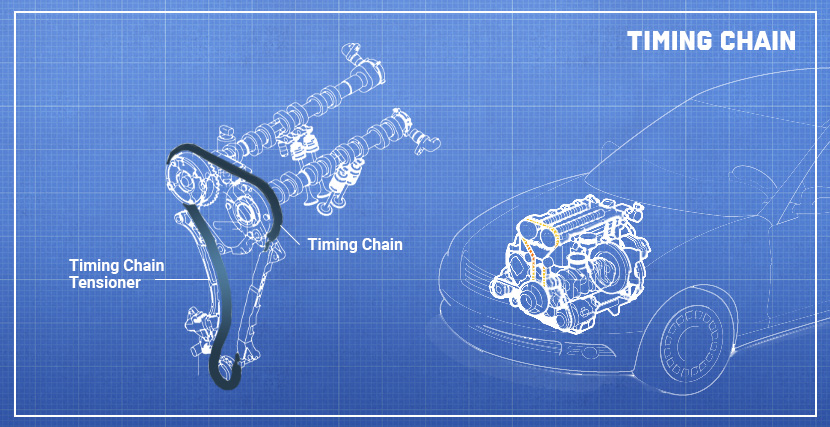Timing Chain
Your timing chain is what keeps your engine’s parts properly synchronized for its smooth and efficient operation. Attached to the crankshaft gear in the bottom half of the engine, it drives the camshaft gear(s) as well as several other engine accessories, such as the water pump or your balance shaft. Thanks to this, your intake and exhaust valves open and close just in time, letting an air/fuel mixture in and exhaust gases out of the engine.

On some vehicles, you’ll not find a timing chain. Instead of it, there is a timing belt or a serpentine belt. Both of them do the same job, providing perfect engine timing, yet have a different design and, therefore, are not interchangeable. Besides, since a timing chain is made from steel, it usually lasts longer compared to a timing belt that needs a replacement every 60000 to 100000 miles. On the other hand, a timing belt runs quieter than a timing chain as it is made from rubber.
A timing chain can be found in nine out of ten vehicles produced till the 1980s. Today, it shares first place with a timing belt or a serpentine belt that is commonly used in lighter and smaller vehicles.
Just like many other engine parts in a vehicle, a timing chain is prone to wear and tear. It can either stretch or break, causing an array of problems:
Lack of engine performance
If your timing belt stretches, it will affect valve timing, resulting in rough running, misfires or backfires. Whichever happens, this will reduce engine performance.
Illuminated check engine light
As it mentioned above, a stretched timing chain can cause misfires and backfires, which is sure to affect emissions. Once this happens, your engine control unit will turn on the check engine light.
You can’t start the engine
If your timing chain breaks, no air and fuel will get into the engine, which means it won’t start.
Overheating
On some vehicles, a water pump is operated by a timing chain. If the latter starts skipping teeth on the water pump’s gear, it can malfunction and cause engine overheating.
Severe engine damage
A stretched or damaged timing chain will affect engine timing, so its pistons will hit the valves. If so, both pistons and valves get damaged. Besides, a loose timing chain can also cause damage to other engine components.
How to fix a bad timing chain
As a rule, a stretched or damaged timing chain is not repairable. It should be replaced as soon as a bad timing chain is detected. Unless you are a mechanic, you should hire a professional to have the job done properly. He or she will not only replace a bad timing chain, but also check other engine parts for damage. In most cases, a water pump should be replaced along with the timing chain.
If you get the timing chain broken when driving, it can cause severe damage to the engine. In this case you should do some math to calculate whether your vehicle is worth repairing or it’s cheaper to buy another car.